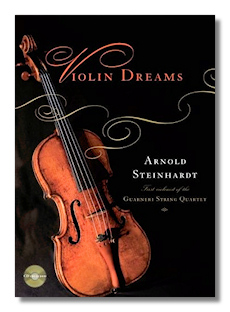
The Internet's Premier Classical Music Source
Related Links
-
Introduction
Acoustics
Ballet
Biographies
Chamber Music
Composers & Composition
Conducting
Criticism & Commentary
Discographies & CD Guides
Fiction
History
Humor
Illustrations & Photos
Instrumental
Lieder
Music Appreciation
Music Education
Music Industry
Music and the Mind
Opera
Orchestration
Reference Works
Scores
Thematic Indices
Theory & Analysis
Vocal Technique
Search Amazon
Recommended Links
Site News
 Book Review
Book Review
Violin Dreams

Arnold Steinhardt
Boston: Houghton Mifflin Co. 2006. 255 pp
ISBN: 0618368922
ISBN 13: 978-0618368921
Summary for the Busy Executive: Far above the usual.
I approached this book like an appointment with the dentist. The Guarnieri was never my favorite string quartet, and I had seen a documentary on the group in which Steinhardt (the first violinist) came across, to put it mildly, unsympathetically, even though he was assistant concertmaster under Szell of my beloved Cleveland Orchestra, where he reminded adolescent me of one of those tall, thin, suave vampires. But what the hell else do I have to do with my life, so I took up my book and read.
The book hooked me from the first. Steinhardt can, for one thing, write. This isn't an as-told-to or as-transcribed-from-a-tape-recorder effort so typical of entertainers' bios. There are real sentences and paragraphs here, stuff many professional writers would envy. However, the structure of the book impressed me most – not so much a bio or memoir but a meditation on what it means to be a professional violinist, a portrait of the unformed person who imperceptibly becomes an artist. Yet nowhere does Steinhardt ever state things so baldly. Indeed, the book remains remarkably free of ego and blowhardry – all the more amazing when you consider that he necessarily talks about himself.
The architecture is quite idiosyncratic. As in a lyric poem (but without the drippy language most people associate with poetry), themes and images bind Steinhardt's thoughts together, rather than chronology: dreams, mountains, the sound of the violin, and, over all, the Bach Chaconne. In some ways, you could read the book as a search for the perfect player, instrument, and audience to realize that piece. Significantly, Steinhardt admits he hasn't achieved perfection. Perfection is always over the hill and around the corner. The problem is that there's always another hill and another corner, no matter how good a player you are.
Despite the serious matters, the book nevertheless has its share of humor and good stories, just like other musicians' reminiscences. Steinhardt's dreams are both poetic and hilarious. Here, however, the laughs have a reason for being.
In addition, you get a bonus CD of Steinhardt playing the Bach d-minor suite for solo violin (the Chaconne's the last movement of this) not once, but twice: a performance from 1966 and one from 2006. The violins, the venue, and the approach all differ. In 1966, Steinhardt seemed to be overcome with the thought, "Oh my God, I'm playing the Mt. Rushmore of violin pieces." Consequently, the playing sounds inhibited, stiff, way too careful, the violin hard and brittle, like a woman heavily made-up, permed, and coiffed in a Schiaparelli straightjacket, the engineering boxy and flat. Furthermore, Steinhardt seems wound even tighter in the Chaconne than in the earlier movements. The new recording improves on this earlier effort in every way. The violin tone is rich and warm (Steinhardt inherited Joseph Roisman's fiddle), and Steinhardt plays more freely, with more of a sense of discovery. Apparently, you can't play a monument as if it were a monument. Like a great oration, the Chaconne talks of important things – maybe even, as Steinhardt suggests, life and death, as well as the joy of thought. It's up to the violinist to convey the sense of urgency and the fun, to shape the music with the sum of his experience and to have the music in turn shape him. If the first recording suggested a young man so insecure that he desperately wanted to be taken seriously by not making any mistakes, the second shows a mature artist – better, a fully-rounded human being – who has lived with the music for decades and has loosened up enough to dance. Even so, one notices links from the earlier reading to the later. First and foremost, one hears a concern for inter-movement correspondences, most clearly in the similarities between the Sarabande movement and the Chaconne. Steinhardt doesn't want to treat the suite's capstone as an encore piece, but as something Bach prepares us for in the earlier dances. Second, Steinhardt wants to find the dramatic shape of each movement, including the massive, 15-minute finale. The book recounts his struggles. The CD tells you the struggles were worth it.
Copyright © 2007 by Steve Schwartz.


















